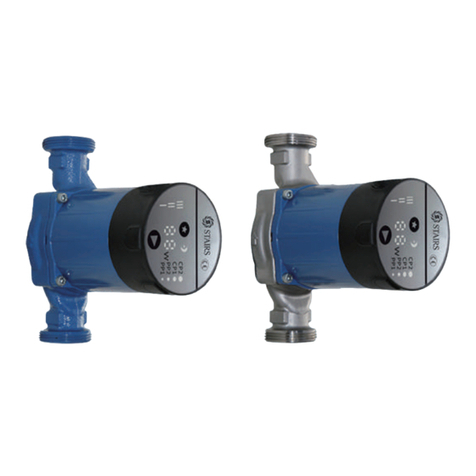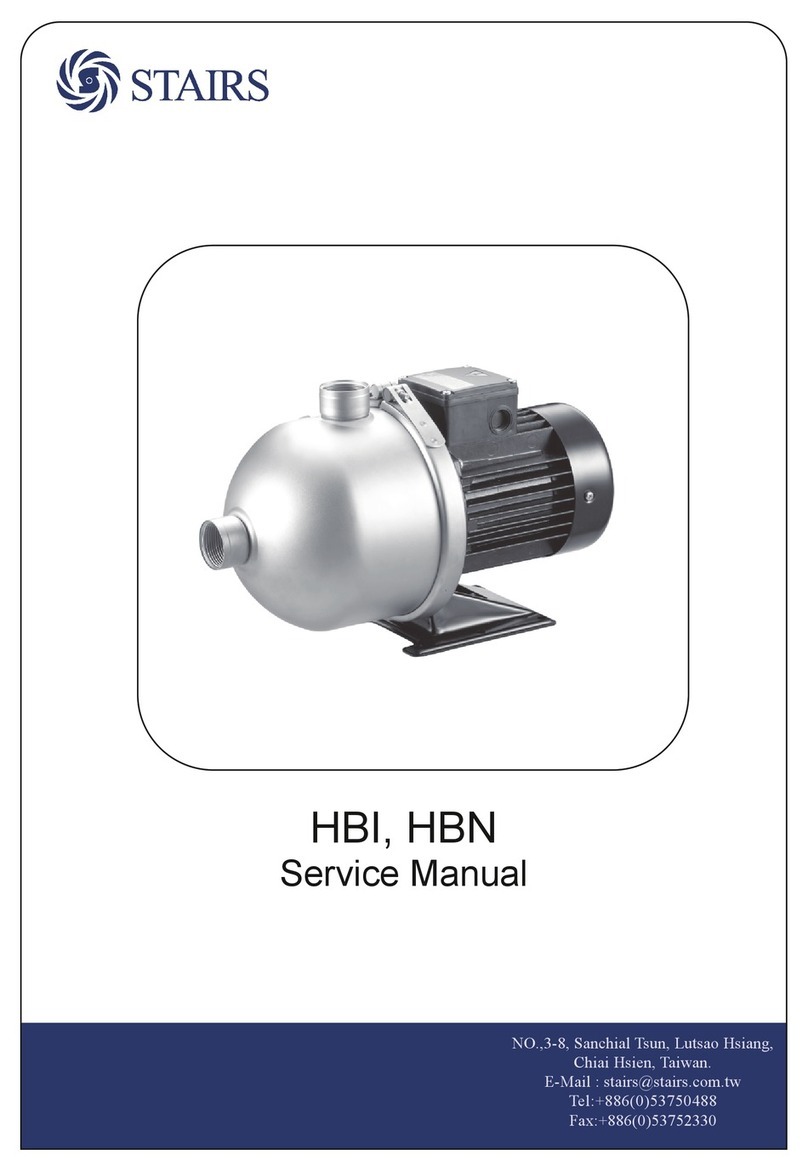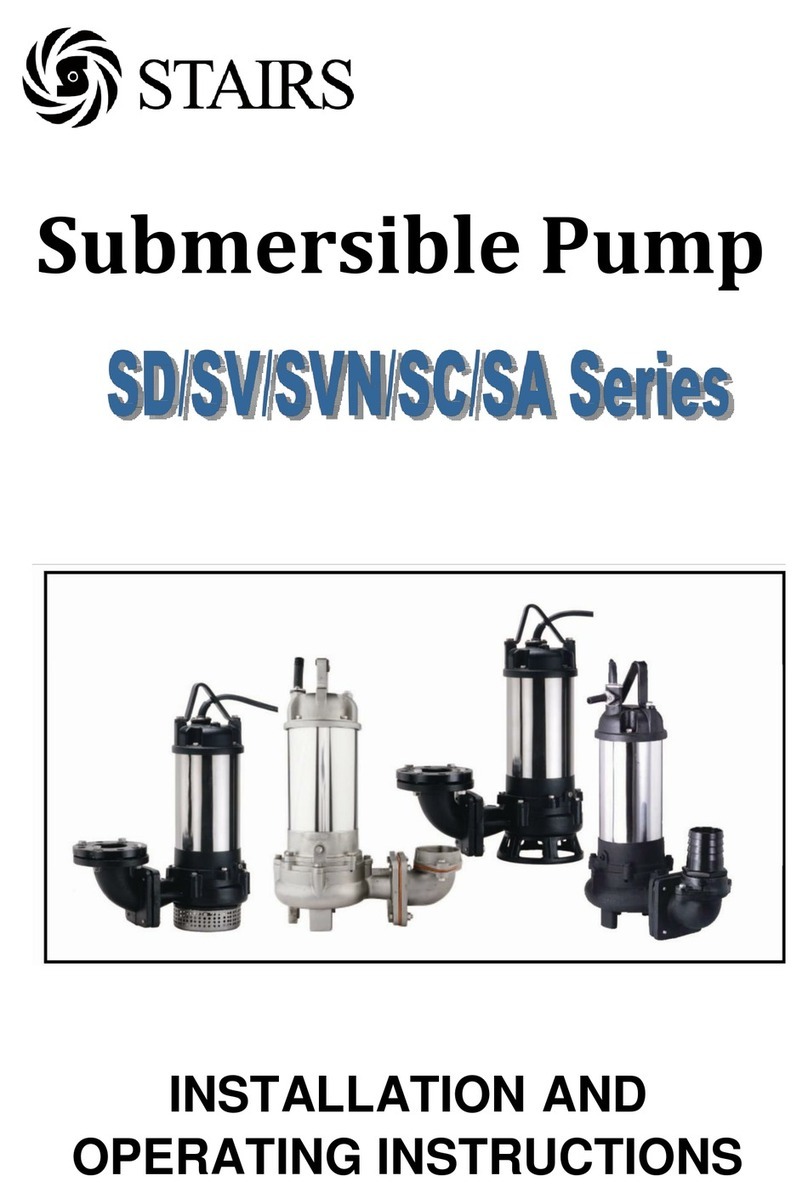
5. Piping joints should be fitted carefully to prevent leaking problem. A leaking problem in the suction line will cause the pump to lose suction
capacity, while a leaking problem in the discharge line will cause the product ON/OFF very frequently even while no any water is in used.
6. In the suction lift application, the connection between the suction line and pump must be airtight, and the suction pipe must be positioned so it has
an upward slope or horizontal to the pump (thus avoiding the formation of air pockets).
• When used on a suction lift, a foot valve should be fitted on the suction line, below the water level.
• If hose is used as the suction pipe, it must be non-collapsible.
• To minimize pressure drop, the discharge pipe should be at least the same size as the discharge port of the pump.
1. Ensure the mains voltage is the same as the voltage of the pump (for the 60Hz dual-voltage models, there is a voltage switch on the IC board inside
the control box) and that the pump is safely connected to ground/earth.
2. The single phase models are optionally supplied with plug and lead. The product comes with plug and lead can be connected directly to the mains
supply. The single phase models without plug and lead and also the three phase models should hook up with a circuit breaker.
Under normal operating conditions, the pump does not require any maintenance as long as the following points are observed:
1. Periodically check the condition of the check value and strainer (if used).
2. If the pump is to be inactive for long periods, it should be rinsed thoroughly with clean water, then, drained and stored in a dry place.
3. If the pump sticks after periods of inactivity, a screw driver slot is provided on the motor shaft end to free up the pump/motor. To do so, insert a
screw driver in the slot in the motor shaft as shown in Fig 3 and turn to free the rotor. If this does not remedy the problem, the unit will need
dismantling.
4. Pressure tank air charge should be checked at regular intervals of every 6 months and after the pump has not been used for a prolonged period. To
check the Pressure Tank air pressure, turn off power, open a tap on the discharge line to release pressure from the pump, unscrew the black
plastic cover and apply an accurate pressure gauge to the valve as shown in Fig 4.
Model Power(HP / W) Preset activation
point ( kg/cm² / psi)
SSA-200(H)
SSA-300(H)
SSA-400(H)
SSA-600(H)
SSA-800(H)
0.25 / 200
0.35 / 300
0.5 / 400
0.75 / 600
1.0 / 750
1.2 / 17
1.6 / 22
2.0 / 28
2.0 / 28
2.0 / 28
The factory preset activation point is as follows:
For most applications , pumps need no adjustment
to operate under normal conditions. It is only
necessary when the inlet pressure is higher than the
factory preset range. It is highly recommended that
the adjustment is performed by the professional personnel.
5. How are the dry-run condition determined and the protection provided?
The dry-run is defined when the motor is running AND the flow rate is less than minimum requirement of 3.0 lpm AND when pressure is less than the
pressure switch setting. The protection is provided:
1. What causes the pump to start?
The pump has the built-in pressure switch and internal flow switch. Each of these can turn the pump on depending on water consumption.
The pump will start when: - The pressure is BELOW the pressure switch activation point. OR - The flow rate is greater than 4.0-5.0 lpm(1-1.3 GPM)
preset activation point for each model is provided in the pump specifications. The cut in pressure must be lower than the pressure switch setting;
otherwise the pump will only start by the flow switch.
2. What is the maximum pressure switch activation point?
Adjust the pressure only when the cut in pressure is higher than the preset activation point. Do not adjust the pressure to exceed the manufacturer
suggestion maximum pressure range as below.
3. What causes the pump to stop?
The flow switch is designed to automatically stop the pump when flow drops to below 3.0 lpm(0.8GPM). The pump will shut off in a few
seconds after flow stops. In addition, the pump will be turned off in the event of dry-run or over-heat alarm.
4. What is the purpose of the built-in pressure tank?
The pressure tank comes from the factory pressurized at approximately 0.8 – 1.6 kg/cm² or 11–22psi (with the pump pressure at zero). It is designed
to minimize motor startup due to small flow demand or minor leak of the pipeline and also to arrest the water hammer.
SSA-200(H) - 2.0 kg/cm² (28 psi) SSA-300(H) - 2.5 kg/cm² (35 psi) SSA-400(H) - 3.0 kg/cm² (42 psi)
SSA-600(H) - 3.0 kg/cm² (42 psi) SSA-800(H) - 3.0 kg/cm² (42 psi)
SSA-200(H): 0.8 Kg/cm² (11 psi) SSA-300(H): 1.2 Kg/cm² (17 psi) SSA-400(H): 1.6 Kg/cm² (22 psi)
SSA-600(H): 1.6 Kg/cm² (22psi) SSA-800(H): 1.6 Kg/cm² (22 psi)
*To avoid dry run without water over 2 minutes, the pump will automatically rest for 15 minutes and restart again, if above cycling happen accumulate
10 times, the rest time will become 90 minutes and restart afterward.
Note: Above unusual pump shutdown, users may stop the power supply over 6 seconds and reconnect again to restart, if it is necessary.
ELECTRICAL CONNECTION
WIRING DIAGRAM
STARTING
WARNING
Risk of Electric Shock - This pump is supplied witha grounding conductor
oragrounding-type attachment plug.
Before operation, please ensure the voltage is correct and the circuit breaker and grounding connectors are all connected
in accordance with local regulations. In addition, please connect the product to an electricity leakage breaker to prevent
more serious electric shock.
,To reduce the risk of electric shock be certain that it is connected only to a properly grounded, grounding-type receptacle.
Fig 1
Water
Fig 2
MADE IN TAIWAN
PRECAUTIONS
OPERATION AND MAINTENANCE
1. The pump should be shut down and the trouble corrected if the pump is running at speed and found to have any of the following problems:
2. Do not allow the pump to continually start and stop (cycling) as this will reduce the motor life.
3. Cycling can occur on pressure units when the pressure tank pre-charge drops, or where there is a leak in the discharge plumbing.
• No water discharged (Green light flash) • Not enough water discharged
• Excessive vibration • Motor run hot
• Pump runs hot (Red light flash) (only apply to the cold water models)
Pressure should be adjusted to the original pre-charge as follows:
Fig 3 Fig 4
ADJUSTMENTS AND RESET PROCEDURES
ADJUST PRESSURE SWITCH (Range: 1.0 – 3.0kg/cm² / 14-42psi)
Instructions for pressure adjustment (Fig. 5):
Open the cover to adjust the pressure
1. If pump does not start when tap is on, adjust clockwise ("+") till it starts.
2. If pump does not stop when no water is consumed, adjust counterclockwise ("-" ) till it stops.
3. After adjustment is made, turn it on and off several times to make sure it operates normally.
Adjust the pressure switch setting (according to the pump models) as shown in Fig 5. Make sure the system is primed.
The pump is supplied with a preset pressure in the pressure switch. For most applications, it will be satisfactory. In some cases a different pressure
may be required. This can be achieved by following the instructions below. However, it is highly recommended that the adjustment is only done by
personnel.the professional
Fig 5
WARNING The pump is not designed for continuous operation under low discharge flows such as slow closing float valves,
slow running taps.
Under this application, please install an extra pressure tank of adequate volume to avoid “cycling”. Leaking discharge line and leaking taps will
damage the unit through causing the pump to repeatedly start and stop.
FREQUENTLY ASKED QUESTIONS
1. Installation where there is no positive inlet pressure for the pump, please follow the procedure as shown in Fig 1.
a. Remove the filling plug b. Fill water in the priming chamber until all air is expelled.
c. Replace the filling plug
2. Installation where the pump inlet is below the water supply, remove the priming plug and allow the water to flow into the
3. The pump must always be checked for prime if not used for a prolonged period. It is imperative to fill the pump with water
4. Installation where the pump is above the water source (suction lift), if there
is no water come up after 2 minutes pump running, please push the
MANUAL START button shown in Fig2 to force the pump to lift the
water until the suction line is full.
priming chamber until all air is expelled.
before operation as dry running will cause irreparable damage to the mechanical seal.
5. Double check the voltage supply is correct then plug in the power. Open the faucet or water appliances on the discharge side. The water should be
delivered after several seconds.
6. Once the water is pumped out, close and open the water appliances on
the discharge side several times to check the automatic ON/OFF operation.
SSA-200(H)
SSA-300(H)
SSA-400(H)
SSA-600(H)
SSA-800(H)
SSA-200(H): 0.8 Kg/cm² (11 psi) SSA-300(H): 1.2 Kg/cm² (17 psi)
SSA-400(H): 1.6 Kg/cm² (22 psi) SSA-600(H): 1.6 Kg/cm² (22psi)
SSA-800(H): 1.6 Kg/cm² (22 psi)

























